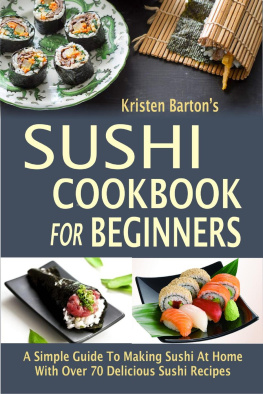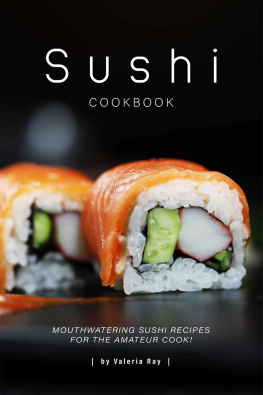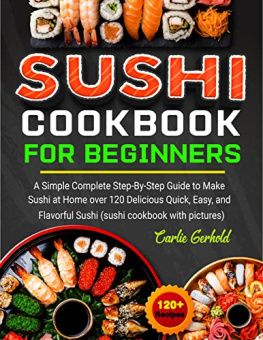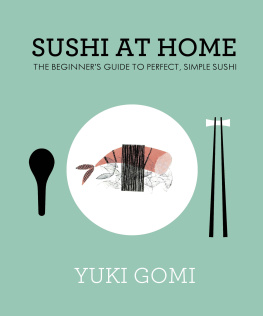Sushi Cookbook For Beginners A Simple Guide To Making Sushi At Home With Over 70 Delicious Sushi Recipes Kristen Barton Copyright 2015 Kristen Barton All rights reserved. No part of this publication may be reproduced, distributed, or transmitted in any form or by any means, including photocopying, recording, or other electronic or mechanical methods, without the prior written permission of the publisher, except in the case of brief quotations embodied in critical reviews and certain other noncommercial uses permitted by copyright law. Limit of Liability/Disclaimer of Warranty: While the publisher and author have used their best efforts in preparing this book, they make no representations or warranties with respect to the accuracy or completeness of the contents of this book and specifically disclaim any implied warranties of merchantability or fitness for a particular purpose. No warranty may be created or extended by sales representatives or written sales materials. The advice and strategies contained herein may not be suitable for your situation. You should consult with a professional where appropriate.
Neither the publisher nor author shall be liable for any loss of profit or any other commercial damages, including but not limited to special, incidental, consequential, or other damages.
TABLE OF CONTENTS
Other Books By Kristen Barton:

D elicious Homemade Jerky Recipes: 43 Jerky Recipes For Easy Meal Times - Beef Jerky, Chicken Jerky, Turkey Jerky, Fish Jerky, Venison Jerky And More

Foraging For Beginners: A Simple Foragers Guide To Wild Edible Plants And Medicinal Herbs
INTRODUCTION

T he popularity of sushi has grown immensely in Western countries over the past few years. Once you've tried a little spicy tuna roll, it is almost impossible not to fall in love with this distinctly unique part of Asian cuisine. Once youve had your first taste, it is very likely you will want another, and another.. And one day, you may want to embark on the culinary adventure of making your first sushi. The most common sushi consists of rice shaped into patties or mounds and topped with raw fish or rolled with fish, roe and vegetables wrapped in seaweed.
There are many forms available to choose from when deciding on sushi. There is rolled sushi, pressed sushi, bowl sushi, sushi in a pocket and sushi by itself. The main ingredient in sushi is rice, in different forms with a variety of fish and vegetables, which gives it a distinctive taste. The same ingredients can be formed in several different ways to create different forms of sushi. Variations of sushi have made their way to the Western World. What once was pure crab meat used in sushi dishes is now imitation crab meat.
The crab meat is tasty however. Beef and chicken are used in some of the sushi dishes, and even some dishes utilize spam, an unknown meat source. Imagination can run wild when creating new dishes. There are also other variations of sushi. There is Latin sushi, which uses a lot of different spices with a Latino flavor. There is Caribbean sushi also, which utilizes tropical spices and fruits.
The Mediterranean Sushi takes on a different flavor. A lot of feta cheese, olives and other spices are used in these. There are many different areas that create their own sushi with their own spices and flavors. Enjoy original sushi or sushi of the area you are in. It is worth your time. You will be able to make many types at home with the recipes in this book.
Experiment with different forms and types of sushi. Enjoy the dipping sauces and the wonderful flavor of the pickled ginger. Your palate will praise you for choosing this enticing, delectable form of food. Incorporate these forms of sushi to be served as a cozy meal for 2 or a meal for several. Have a sushi tasting get together with friends or co-workers. There are surely ones among your circle that have never tried sushi and you can be the one to introduce them.
Make sure there are several choices of sushi and several sides to tempt their palate. Dont forget the wasabi and pickled ginger. Making your own sushi at home will accomplish a number of things for you. One is that you will save a good amount of money. We all know that the sushi you get from sushi bars and Japanese restaurants are often overpriced. The second is the sense of accomplishment that comes with "mastering" this special part of Asian cuisine.
Not only will you gain personal satisfaction for being able to prepare this dish, you will also impress your friends and family with the huge variety of homemade sushi you have expertly crafted. You dont have to be a world class chef to make sushi at home. It is within your grasp as long as you have the basic kitchen skills of combining ingredients. All you need to do is cook some rice, get some nori, slice some fish and vegetables and then roll them all together! Your first few tries may not end as lovely as you expected. Rolls will be uneven, rice will be loosely packed and some ingredients may fall out. However, with a lot of practice, you will get the presentation right and you will soon start making lovely and elegant sushi right in your own home.
Below is a guide for making your own sushi at home.
Beginners Guide To Making Sushi At Home
. Know The Different Sushi Presentation Styles Sushi is presented in different styles and you will prefer some to others. Here are the common types of sushi: Makizushi (Sushi Rolls): This includes Chumaki (medium roll sushi), Futomaki (thick roll sushi that has several fillings), Hosomaki (thin roll sushi with a single filling), Temaki (hand roll with a cone shape) and Uramaki (inside-out roll sushi that has nori on the inside and rice on outside) Nigirizushi (Hand-Formed Sushi): This consist of sushi rice hand formed into a rectangle with a slice of fish or seafood on top Chirashizushi (Scattered Sushi): This consist of a bowl with sushi rice topped with sliced raw fish and often with vegetables. Inarizushi (Sushi Wrapped In Something That Is Not Nori): This is usually sushi ingredients wrapped in tofu pouches. Oshizushi (Pressed Sushi): This is sushi that is made and pressed into wooden molds.
The rectangular box of sushi is then cut into smaller rectangles or squares before serving. Sashimi: This is just raw fish or seafood served without sushi rice. 2. Get The Necessary Equipment The right tools will make it easier for you to make sushi at home. Here are the basic tools you require: Rice cooker: A rice cooker has a consistent cooking process and provides more convenience because you dont have to constantly watch or stir. On the other hand, if you do not want to commit to a rice cooker immediately, you can use a plain old non-stick cooking pot that has a lid.
Sushi-grade knives: The sushi knife is nice to have to help you slice your sashimi and creating the art. They are extremely sharp which helps to create a nice smooth appearance. You need a few sharp knifes for cutting fish, veggies and sushi rolls. Basically, you should have a heavy chefs knife with a curved blade, a long slim and very sharp fish knife that will also double for sushi rolls and lastly a knife that you will use to peel, cut and chop vegetables. Rice rolling mat (bamboo): The ultimate must have is a bamboo mat. The art of rolling maki is a lot easier when you have this mat.
It helps when pressing and forming the roll. Plastic wrap: To keep rice from sticking to the rolling mat. It also prolongs the life of the mat since you will not have to wash it too frequently. Large wooden mixing bowl : A hangiri (Japanese round, flat-bottomed bowl) is helpful in mixing rice with your seasonings for sushi rice. This is needed for mixing as well as cutting sushi rice. You could also use a plastic bowl.
Next page









 D elicious Homemade Jerky Recipes: 43 Jerky Recipes For Easy Meal Times - Beef Jerky, Chicken Jerky, Turkey Jerky, Fish Jerky, Venison Jerky And More
D elicious Homemade Jerky Recipes: 43 Jerky Recipes For Easy Meal Times - Beef Jerky, Chicken Jerky, Turkey Jerky, Fish Jerky, Venison Jerky And More  Foraging For Beginners: A Simple Foragers Guide To Wild Edible Plants And Medicinal Herbs
Foraging For Beginners: A Simple Foragers Guide To Wild Edible Plants And Medicinal Herbs  T he popularity of sushi has grown immensely in Western countries over the past few years. Once you've tried a little spicy tuna roll, it is almost impossible not to fall in love with this distinctly unique part of Asian cuisine. Once youve had your first taste, it is very likely you will want another, and another.. And one day, you may want to embark on the culinary adventure of making your first sushi. The most common sushi consists of rice shaped into patties or mounds and topped with raw fish or rolled with fish, roe and vegetables wrapped in seaweed.
T he popularity of sushi has grown immensely in Western countries over the past few years. Once you've tried a little spicy tuna roll, it is almost impossible not to fall in love with this distinctly unique part of Asian cuisine. Once youve had your first taste, it is very likely you will want another, and another.. And one day, you may want to embark on the culinary adventure of making your first sushi. The most common sushi consists of rice shaped into patties or mounds and topped with raw fish or rolled with fish, roe and vegetables wrapped in seaweed.